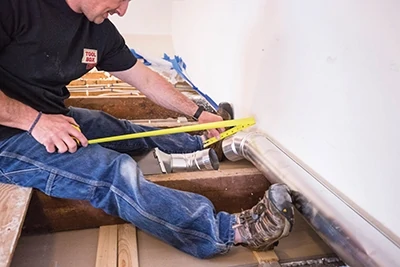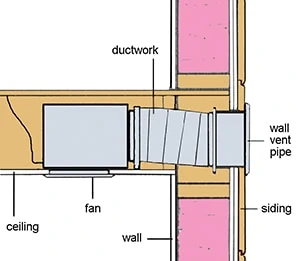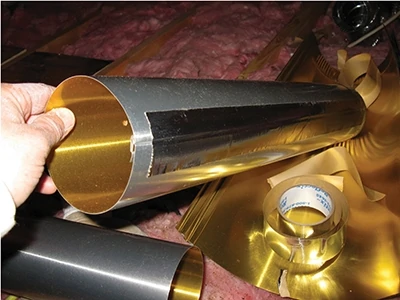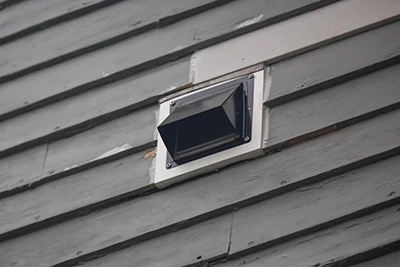Circulate fresh air and get rid of unwanted moisture.
By Rob Robillard
Prior to and even during a bathroom remodel, I often have conversations about tile and fixture layout, style and finish. But the conversation seldom leads to discussion of bathroom ventilation, issues like CFMs, minimizing ductwork and the placement of external heads and backdraft dampers.
In my Boston Globe column and on my ConcordCarpenter website, I often receive questions relative to ventilation and moisture in bathrooms. Unfortunately, there’s plenty of misinformation about bathroom ventilation.
Some folks ask if it’s okay to vent moist shower air into a roof soffit or unheated (but vented) attic. Others ask whether they should be concerned about their current “mile-long” plastic duct tubing.
Then there are those who complain of having a mystery stain on their ceiling. The stain is the result of a fan pipe that was installed through an unheated attic where moisture built up from a pipe dip, froze, and months later melted, staining the plaster ceiling below. Mystery stain solved!
Not venting a shower or improper venting can result in high humidity in the bathroom. When bathroom humidity builds up, warm moisture-laden air moves toward cooler wall surfaces, where it condenses back into water.
Moist air can also work its way into a wall cavity and condense inside the wall. Both situations can result in mold, odors and sometimes structural damage.
Moisture will also peel off wallpaper or paint. Seeing or smelling mold and mildew is a good indicator that you have a high moisture problem.
So how do we remodel our bathrooms and still enjoy that hot, steamy shower and avoid mold problems?

The only effective way to prevent mold is to attempt to keep indoor moisture levels low. A properly vented bathroom shower fan will remove moisture and decrease the humidity in your house.

Choosing the Best Exhaust Fan
The most important feature in a bathroom shower fan is its ability to remove moisture not only as it’s created but also while moisture droplets are floating in the air prior to condensing on the walls and ceilings.

In order for a bathroom fan to do its job you need to focus on five main points:
- Sizing the fan to the room
- Placing the fan in the best location to succeed
- Installing the fan properly
- Mitigating fan noise
- Timer switch
Sizing the Fan
Prior to purchasing your bathroom fan you’ll need to size it to your room so it can adequately handle the airflow for that space. That means you need to match the fan CFMs to the size of your bathroom. Most people size the fan to the room dimensions correctly but fail to factor into their calculations the length of duct run and elbows.
Determining the minimum CFM of your bathroom is easy, simply multiply the room’s width × length × height × 0.13.
Many fans will list the maximum duct run that is allowed. Remember to include the duct run length and any elbows in your calculations. Adding an elbow connector or an external vent hood with a backdraft preventer will add approximately 10 to 15 feet of duct length. You may need a higher CFM rated fan if your ductwork is long or complicated.
You should also consider the ACH, the air exchange per hour, that is: an air flow rate sufficient to remove the air volume in a given room at a specified number of times each hour. Your bathroom exhaust fan should be sized properly to completely change out the air in the bathroom at the rate of 11-15 changes in one hour.
Fan Location
Locate your bathroom fan to ensure maximum moist air extraction.
Steam rises, so the shower ceiling is always a good spot for a shower fan. If that location is not feasible then place the fan just outside the shower.
In cathedral ceilings sometimes a sofit built over the shower can accommodate the fan or a high-mounted wall fan can be installed.
Install the Fan Properly
Bath fan ducting can negatively affect fan performance. Un-insulated, undersized, or droopy flex ducting and excessive length or excessive use of elbows all can negatively affect the fan’s rated airflow.
In order to keep the fan effective, try to lay out your installation with minimal turns.

The best duct pipe to use is solid smooth aluminum. Solid duct pipe results in better airflow because it has less air drag and is easier to keep in a straight run to avoid drooping.

When installing solid pipe, create a slight pitch toward the exterior of the building in case water condenses in the pipe. You want to avoid moisture draining back toward the fan.
Take steps to properly support your pipe run either from below, with blocking or from above, with plumbing strap or large, heavy-duty cable ties (with screw holes in them). I use metal plumber’s tape—it’s a galvanized strapping with holes every 1/2 inch for screws.

Install the pipe with all seams facing up and seal these seams and all joints with aluminum tape (not duct tape). Keeping your pipe seams at the top will prevent moisture leakage in the house. Small sheet metal screws are acceptable with bath vent pipe, but the aluminum tape works fine without them.
Pro Tip: Make sure you dry-fit and install the pipe to the exterior vent hood prior to installing screws or tape. You may want to attach the hood to the pipe from the exterior and then slide it into the house wall.
If the duct pipe will run through non-conditioned spaces (crawlspaces and attics), make sure to install an insulation sleeve over it to prevent the moist air from freezing inside the pipe.

A bathroom fan MUST be vented to the exterior of the building to avoid moisture-related issues.
This is often completed with a wall, soffit or roof cap. When possible, I choose to vent my fans out an exterior wall through a backdraft-protected exterior hood.
Pro Tip: On installations with beveled clapboard or shingle siding I often cut the siding back and install a PVC backerboard to the house. I flash this board and pre-drill a hole through it to allow the vent hood to sit flush to the board, thus preventing large gaps.

Fan Noise
When selecting a vent fan, consider how much noise they make. Bathroom exhaust fans measure noise in sones.
Rather than a 4-6 sone bathroom fan, look for one that’s close to or at a 1.5 sone rating—a much quieter fan. You may have to put up with some noise for a more powerful fan, depending on the fan’s size and pipe run layout.

Most fan labels have Home Ventilating Institute (HVI) ratings so you can compare noise and energy efficiency. Choose the quietest, most energy-efficient fan that will do the job for you.
There are many quality brands: Nutone, Panasonic, Ventech, and Broan. I suggest choosing a fan with a ball-bearing motor for quality and longevity.
Fan Controls
It’s recommended that a bath fan run not only during but for 20 minutes after using the shower—and with the bathroom door closed.
Many people still use an on/off switch for their shower fan. There are two obvious problems with this type of switch. Either people turn the fan off after showering, which leaves a lot of moisture in the air, or they forget and leave the fan on, possibly for hours. I have two daughters who would sometimes leave the fan on all day until I found it running when I came home after work. That’s a lot of heat or AC expelled from the house during the day! As a result I installed a fan timer that has a humidity sensor so it will turn on automatically if they forget or if the room’s humidity is too high.

The best way to ensure that your bathroom fan has the time it needs to achieve proper air exchanges is through the use of a shower fan timer. Fan timers come in all styles, but I prefer the ones that are preset or allow you to set the fan at the time of installation. I have my fans set to 30 minutes, which covers a 10-minute shower and 20 minutes of run time. If the shower takes longer, I reset it prior to leaving the bathroom.

Choosing and installing the best fan for your location is an important part of your bathroom remodel. A quality bathroom fan, properly installed will remove moisture and odors from your bathroom and will improve your indoor air quality.
Remember to take the time to thoroughly understand your bathroom ventilation needs and to follow the manufacturer’s instructions as well as these best practices for installation procedures. The result will be FAN-tastic!
Side Note
Duct Installation Tips
Seal all joints in the pipe, elbow and connection seams with aluminum tape (not standard duct tape).
When possible, use smooth, solid aluminum duct. Ribbed plastic duct can develop dips where moisture can condense and pool, and eventually cause odors or leak into the ceiling below. Over time the flexible plastic can also become brittle and crack, so the solid aluminum duct is a better quality material.
Smooth, solid aluminum duct has less air resistance than the ribbed plastic duct.
Install the duct with the seams facing upward and with a slight slope toward the exterior vent hood. In unconditioned attics or crawlspaces, insulate the duct.
Bathroom vent ducts must always terminate on the outside of the house.
Vent to the outside of the house using a backdraft-protected hood.










